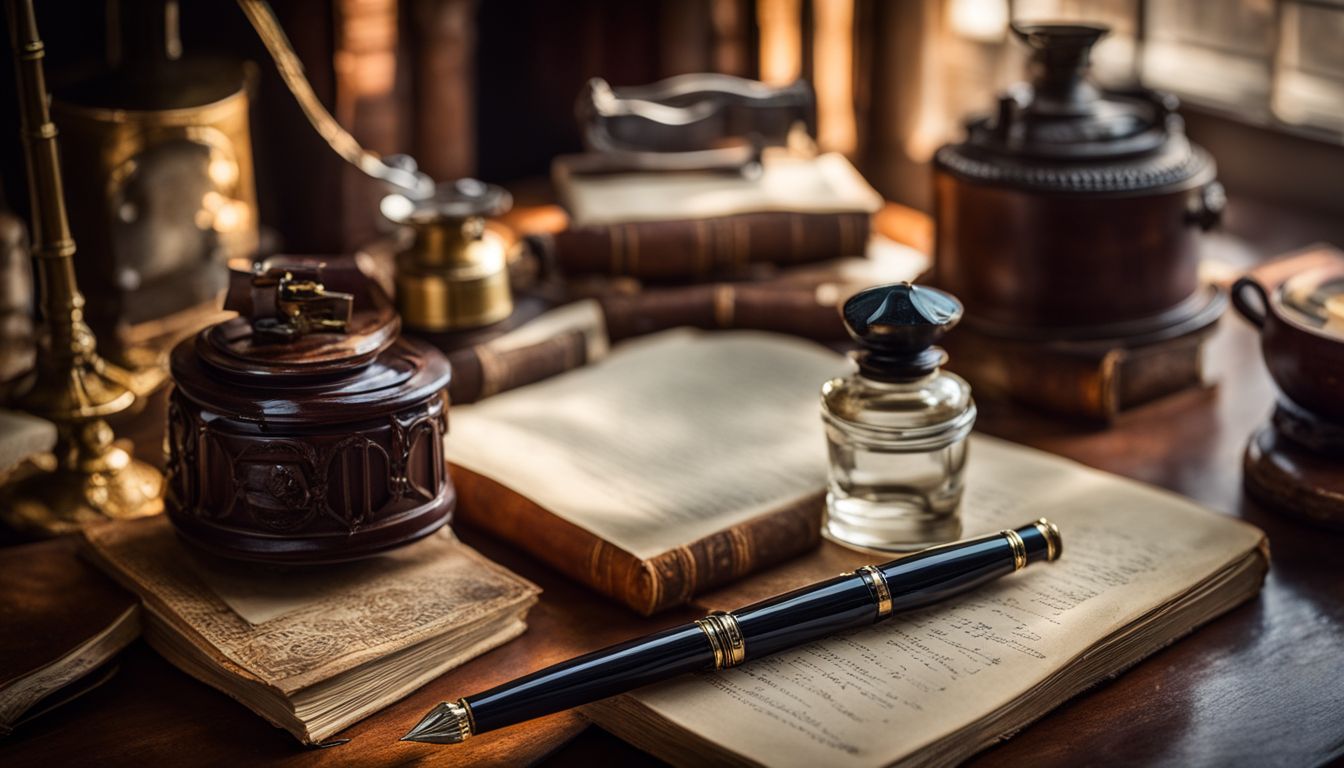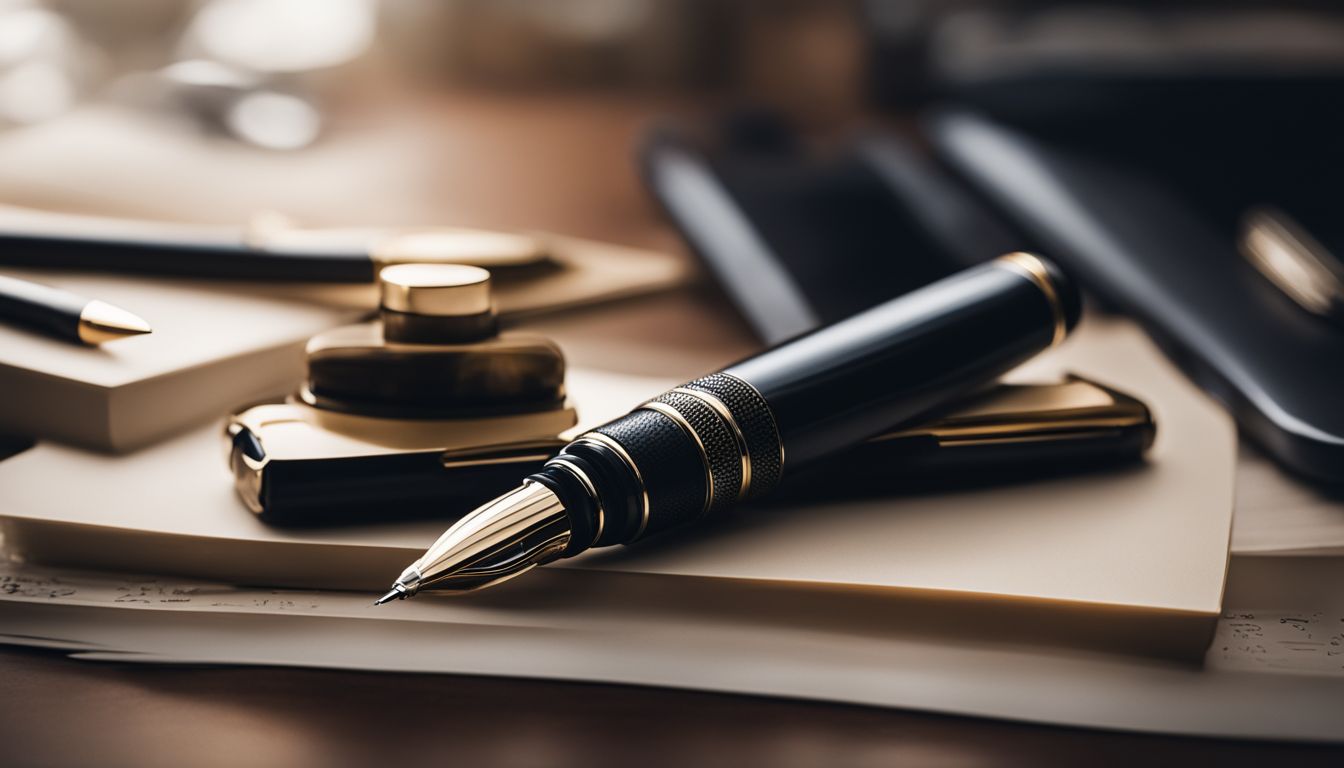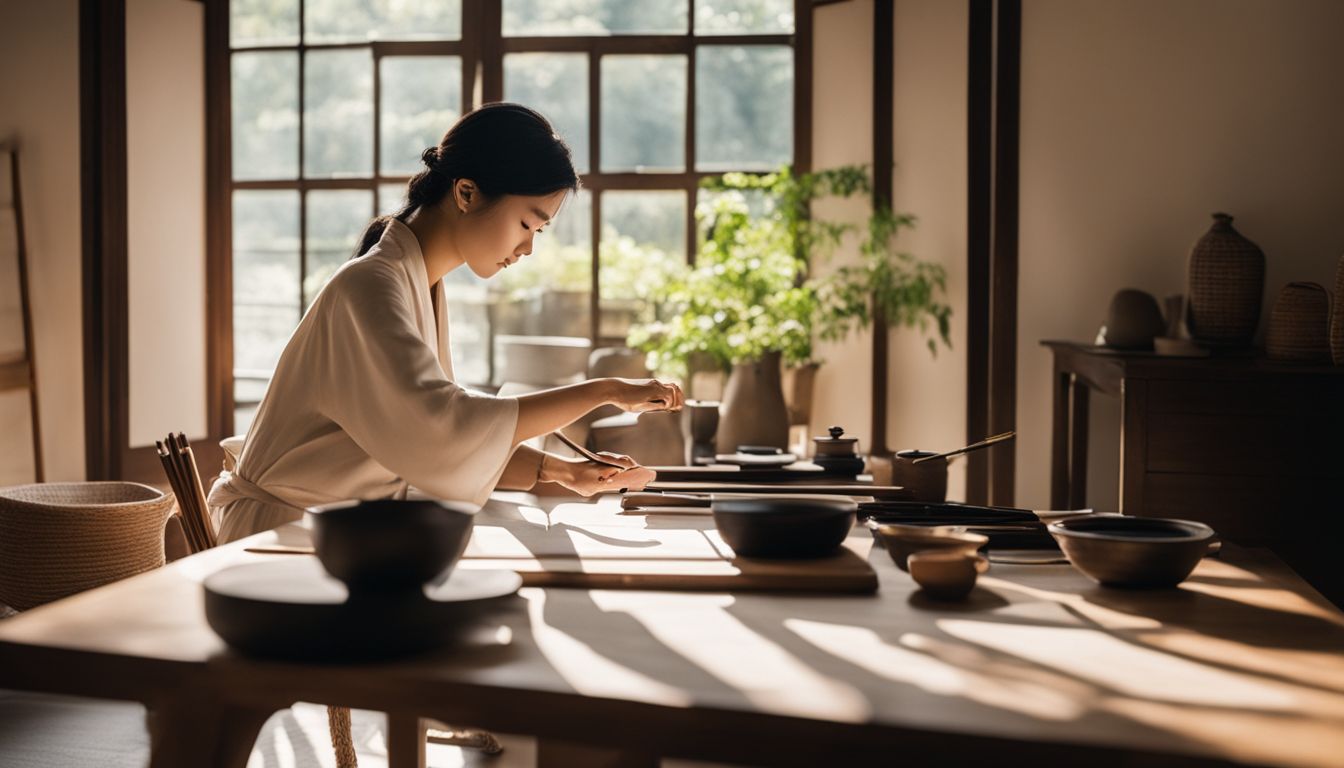Have you ever been swamped with choices when hunting for that perfect fountain pen, like searching for a single blade of grass on an expansive lawn? You’re not alone. It can feel like a real maze, sifting through the endless sea of pens available.
But fret not—I’ve poured over the details and sifted through the abundance to streamline your search. In this post, we’ll cut straight to what’s important, guiding you towards finding your ultimate writing ally.
So get ready; let’s unravel the mystery together and find that special pen that feels just right in your hand!
Key Takeaways
- Your fountain pen choice should match your writing style and comfort, considering nib types like broad or extra fine for different line weights and italic versus round for artistic flair or consistency.
- Consider the ink filling system that suits your needs, from easy-to-replace cartridges to refillable converters or built-in systems in eyedropper pens.
- Pay attention to the pen’s size and weight to ensure it feels good in your hand; materials like metal can be heavier but provide a solid grip, while resin offers lightness and color variety.
- Keep an eye on craftsmanship and material quality, as these affect both the look and longevity of a fountain pen; gold nibs offer flexibility, while steel is more affordable.
- Regular maintenance like cleaning the nib ensures smooth ink flow and prolongs your fountain pen’s life; store pens properly to avoid drying out.
The Allure of Fountain Pens

Fountain pens offer a smooth writing experience that can’t be matched by ballpoint or rollerball pens. They also have the ability to improve handwriting and can last for years with proper care.
These factors make fountain pens an alluring choice for writing enthusiasts and collectors alike.
Smooth Writing Experience
A smooth writing experience is a game-changer with fountain pens. The moment the nib touches paper, it glides effortlessly, almost like dancing across the page. This isn’t just about style; it’s about how the ink flow feels in your hand.
As I use my pen, thoughts pour onto paper without any skips or scratches—something ballpoints or rollerballs often can’t match.
The secret lies in choosing the right nib for that buttery feel—a gold nib flexes gently with pressure, while steel nibs offer consistency and strength. Each stroke reflects my personality and mood, making writing more than just a task—it becomes a joyful expression of creativity.
Plus, with no strain on my wrist due to smooth ink delivery, I can write longer without getting tired!
Improvement in Handwriting
Fountain pens have a secret power—they can make your handwriting look better. With each stroke, the pen glides across the paper, encouraging you to slow down and form letters more carefully.
This isn’t just me saying it; many people notice their script becomes neater and more consistent with practice. The way a fountain pen flows helps you pay attention to spacing and sizing.
Your choice of nib also plays a role in how your writing looks. A broad nib will give your letters a bolder feel, while a fine nib offers precision and delicacy. No matter what nib you choose, remember that tuning or smoothing might be needed if it’s not quite right at first.
Stick with it, though—over time, using these classy writing instruments could take your cursive from messy to masterpiece!
Longevity and Durability
A good fountain pen is a buddy for life. Unlike ballpoints that get tossed after they run dry, my fountain pens stick around. They’re built to last and can handle the bumps and knocks of daily use.
With proper care, these pens often become heirlooms passed down through generations.
I’ve seen steel nibs withstand the test of time; they are solid and dependable. But oh, gold nibs have their own charm—they flex with flair and maintain their strength beautifully.
The materials matter too, from lustrous resins to robust metals; each contributes to the pen’s endurance and character.
Nib Selection for Your Fountain Pen

When it comes to choosing the right fountain pen, one of the most important considerations is the nib. Whether you prefer a broad or extra fine nib, or even an italic vs. round nib, understanding how each type affects your writing experience is crucial.
It’s important to explore different options and find the best fit for your individual needs and preferences.
Broad Nib vs. Extra Fine Nib
As a fountain pen enthusiast, I know that the heart of the writing experience lies in the nib. Choosing between a broad nib and an extra fine nib affects not just how your writing looks but how it feels to put pen to paper. Let’s lay out the differences on the table, shall we?
| Broad Nib | Extra Fine Nib |
|---|---|
| Creates bold, expressive lines | Delivers precise, detailed writing |
| Ideal for signatures and calligraphy | Perfect for small print and intricate work |
| Requires high-quality paper to prevent bleeding | More forgiving on lower-quality paper |
| Uses more ink, can be less economical | Conserves ink, lasting longer between refills |
| Can be smoothed out if it feels too scratchy | May require tuning for optimal flow |
Diving right into it — broad nibs are showstoppers. They invite the writer to make a statement with every stroke. Think grand gestures and a sense of flair; that’s what writing with a broad nib feels like. It’s a bold move, but remember, they can be demanding about the paper quality. A bad experience can often stem from poor paper rather than the nib itself.
Swinging over to the other side, extra fine nibs have their distinct charm. They’re like the fine-pointed brush of an artist — meticulous and precise. These nibs are my go-to for notetaking or when I’m working with a complex layout. They’re thrifty with ink too, which is a plus if you’re jotting down pages of thoughts regularly.
Both broad and extra fine nibs have their places in a writer’s arsenal. Your choice heavily relies on personal preference and the purpose behind your writing. Keep in mind that a nib’s temperament can often be tweaked through careful tuning, so a less-than-ideal initial feel doesn’t spell disaster.
Balance and weight do play a pivotal role for me, potentially outweighing the nib’s width. A well-balanced fountain pen, regardless of the nib size, turns writing into a seamless extension of my thoughts. And isn’t that what we’re all after?
Italic Nib vs. Round Nib
Moving from the breadth of lines offered by broad and extra fine nibs, we now delve into the artistic flair of italic nibs versus the consistency of round nibs. It’s a decision that colors every stroke you make—choosing between the expressive calligraphy-like script and the uniformly neat penmanship. Let’s get this straight, your choice here majorly influences the personality of your writing.
| Italic Nib | Round Nib |
|---|---|
| Known for its edgy strokes and variable line widths, often used in calligraphy. | Delivers a consistent line width, perfect for straightforward, everyday writing. |
| The sharp edges can provide a dramatic flair to lettering, adding character to your script. | A smoother writing experience, round nibs are forgiving for beginners and long writing sessions. |
| Favored by artists and calligraphers for its decorative potential. | Widely preferred for note-taking, journaling, and general tasks. |
| May require a bit more skill and control to use effectively. | Dependable for a no-fuss approach to writing, they are versatile and reliable. |
Whether you’re looking to add some panache to your handwriting or seeking a reliable tool for your daily writing needs, the nib’s shape dramatically shapes your experience. The italic nib tempts with its distinctive style, while the round nib promises ease and evenness. Go on, let your pen tell its own story.
Understanding the Fountain Pen Size and Weight
When selecting a fountain pen, consider the size and weight to ensure writing comfort. A heavier pen may cause fatigue during prolonged use, while a lighter one may lack balance. The ideal size fits comfortably in your hand and supports your natural writing posture.
The materials used impact both the weight and feel of the pen. Metal pens tend to be heavier, providing a solid grip, while resin or plastic models are usually lighter and offer more variety in colors and designs.
It’s important to try different sizes and weights to determine which feels most comfortable for your unique writing style.
Ink Filling Systems for Fountain Pens
There are different ink filling systems for fountain pens, including cartridge, converter, and built-in or eyedropper system. Each has its own advantages and considerations, so it’s important to choose the right one based on your preferences and needs.
To learn more about how these systems work and which one might be best for you.. [Read More].
Cartridge Fountain Pens
Cartridge fountain pens provide convenience and simplicity for everyday writing tasks. They appeal to beginners and those who prefer a clean ink filling system. With a wide range of replaceable ink colors, cartridges offer seamless continuity for uninterrupted writing sessions.
These pens are an ideal choice for anyone seeking straightforward and hassle-free writing experiences, making them perfect for on-the-go usage.
The variety of ink colors available in cartridges adds versatility to your writing, allowing you to express yourself with different shades without any mess or fuss. Plus, the ease of replacing cartridges means that you can effortlessly switch between colors based on your mood or task at hand, ensuring a smooth and enjoyable writing journey every time.
Converter Fountain Pens
Converter fountain pens provide a versatile way to enjoy a wide array of ink colors, allowing for personal expression through writing. With a larger ink capacity than cartridge pens, they are an excellent choice for those who write extensively, such as students and professionals.
The flexibility to refill the converter with different inks caters to individual preferences and needs, particularly beneficial for those seeking distinct ink properties or colors not readily available in pre-filled cartridges.
However, it’s important to note that certain brands may have proprietary cartridges designed specifically for their converter fountain pens, limiting color options unless individuals manually refill these cartridges.
The larger ink capacity and adaptability of inks make converter fountain pens an attractive option for enthusiasts looking to expand their writing experience with diverse colors and properties.
Built-In and Eyedropper Filling System Fountain Pens
When it comes to ink filling systems, built-in and eyedropper filling system fountain pens are a practical choice for daily use. The built-in system offers convenience as the pen is pre-filled with ink, while Japanese-style eyedropper pens with a valve prevent spillage due to the vacuum seal design.
With these options, you can enjoy a steady supply of ink without frequent refills or concerns about leaks.
In addition, Japanese-style eyedropper pens often hold more ink than other systems, making them ideal for everyday writing. This means less time spent on refilling and more time enjoying the smooth writing experience these fountain pens offer.
The Role of Craftsmanship and Material in Choosing a Fountain Pen
Craftsmanship and material deeply influence a fountain pen’s appeal. The finishing, trim, and materials used affect the pen’s aesthetics and worth. When choosing a fountain pen, the type of nib and its material – gold, steel, or alloys – are crucial factors to consider.
Gold nibs excel in quality, flexibility, and strength; however, steel nibs present a more budget-friendly option. Additionally, weight and size play significant roles in user comfort during writing activities since they are determined by the construction materials utilized.
The endurance and elegance of these pens largely hinge on craftsmanship. High-quality materials like urushi lacquer or makrolon confer durability while also enhancing visual allure.
With this thorough understanding of craftsmanship significance when selecting a fountain pen.. bear these factors in mind to make an informed purchase decision reflecting your individual style preferences!
How Price Ranges Influence Fountain Pen Selection
Price ranges heavily influence fountain pen selection. When considering budget, it’s essential to prioritize personal preferences and writing needs. In the market, a wide variety of options are available across different price points, offering reliability and quality construction.
For instance, PenBBS provides affordable yet dependable writers that cater to various preferences and financial circumstances.
The range in pricing caters to diverse audiences – from collectors seeking high-end luxury pens to everyday users looking for reliable yet budget-friendly options. It’s crucial not to overlook the value and performance offered by mid-range models like the Lamy Safari or Pilot Metropolitan, providing an excellent balance between quality and affordability.
Ultimately, understanding how price impacts features and materials helps in making an informed decision when selecting a fountain pen that aligns with both personal preferences and financial considerations.
Getting Started with Your New Fountain Pen
Once you’ve chosen the perfect fountain pen, it’s time to adjust to its writing style, experiment with different inks, and care for your new pen. There are plenty of tips and tricks to help you get started on this exciting journey with your new favorite writing tool! Keep reading to learn more about how to make the most of your fountain pen experience.
Adjusting to the Writing Style
As I adjust to the writing style of fountain pens, I find that experimenting with different inks has a significant impact on my experience. Trying out various colors and types of ink adds a personal touch to my writing and allows me to explore the full potential of my chosen pen.
Furthermore, taking the time to understand and appreciate the craft behind different nibs has helped me fine-tune my handwriting and discover which style suits me best.
Exploring a variety of inks not only adds vibrancy to my writing but also provides an opportunity for self-expression through color choices. Understanding the craftsmanship behind each unique nib ensures that I can fully optimize my fountain pen for an enjoyable writing experience.
Experimenting with Different Inks
When starting with a new fountain pen, it’s crucial to experiment with different inks. The choice of ink color impacts the writing experience and personal preference. It’s also important to note that different inks can impact the maintenance and care of the fountain pen.
Trying out various ink colors can significantly enhance your writing experience, as each hue may interact differently with your paper and nib. Additionally, experimenting with different inks allows you to find the perfect combination that suits your style and preferences, making each writing session an enjoyable one.
A comprehensive understanding of how different inks work can help maintain the longevity of both your pens and handwritten documents.
Caring for Your Fountain Pen
Experimenting with different inks can be quite the adventure, but once you’ve found the perfect ink for your fountain pen, it’s crucial to care for it properly. Regular maintenance is key to keeping your fountain pen in prime condition.
Ensure to clean it thoroughly with lukewarm water whenever you change the ink color or after extended periods of disuse. This helps prevent clogging and maintains a smooth ink flow, ensuring that your writing experience remains impeccable.
Additionally, store your fountain pen horizontally when not in use to prevent ink from settling and potentially causing flow issues when you next pick up the pen.
Caring for Your Fountain Pen: Maintenance Tips and Tricks
Maintaining your fountain pen is crucial to ensure its longevity and optimal performance. Here are some essential tips and tricks:
- Cleaning the nib regularly helps prevent clogging and ensures smooth ink flow.
- Using a mild soap solution or pen flush, flush out old ink residue from the pen’s components.
- Always store your fountain pen with the nib pointing up to prevent ink from settling and drying in the feed.
- Avoid exposing your fountain pen to extreme temperatures, as it can affect the ink’s consistency and the pen’s overall function.
- Periodically check and clean the converter or cartridge to prevent any ink buildup that may affect performance.
- Use only high-quality, fountain-pen-friendly inks to avoid potential damage to the pen’s internal mechanisms.
- When not in use, cap your fountain pen securely to prevent evaporation of the ink and maintain its consistency.
- If you won’t be using your fountain pen for an extended period, consider cleaning it thoroughly before storing it.
- Regularly inspect the nib for any signs of misalignment or damage that may impact writing quality.
Conclusion
Choosing the perfect fountain pen boils down to personal preference and budget. Don’t overspend – keep it practical for daily use. Consider the filling system, nib choice, weight, and balance for a pen that feels right in your hand.
Embrace the joy of finding the ideal fountain pen that complements your writing style and brings elegance to your everyday tasks.
To keep your new fountain pen in pristine condition, make sure to read our comprehensive guide on fountain pen maintenance.
FAQs
1. What should I look for when choosing a fountain pen?
Look for the right nib material, like stainless steel or gold, and choose between ink cartridges or bottled ink. Consider pen durability and the ergonomics of writing to suit your hand.
2. Is there a difference between piston filler and vacuum filler pens?
Yes, there’s a big difference! A piston filler draws up ink with a twist mechanism while a vacuum filler uses air pressure to fill. Both are great for using different inks from bottles.
3. Can I use my fountain pen for calligraphy?
Absolutely! Pick one with flexible nibs that adjusts to pressure—perfect for fancy cursive writing and adding flair to your letters.
4. Why choose Pilot Custom 823 over Platinum Plaisir?
Pilot Custom 823 is higher-end, offering smooth writing with its vacuum-filler system; whereas Platinum Plaisir is more affordable but still delivers quality as an everyday pen.
5. Are fountain pens only for serious pen collectors?
Not at all! Whether you love jotting down notes or enjoy crafting beautiful letters, there’s a fountain pen out there just waiting to become your go-to writing utensil.




Leave a Reply
You must be logged in to post a comment.